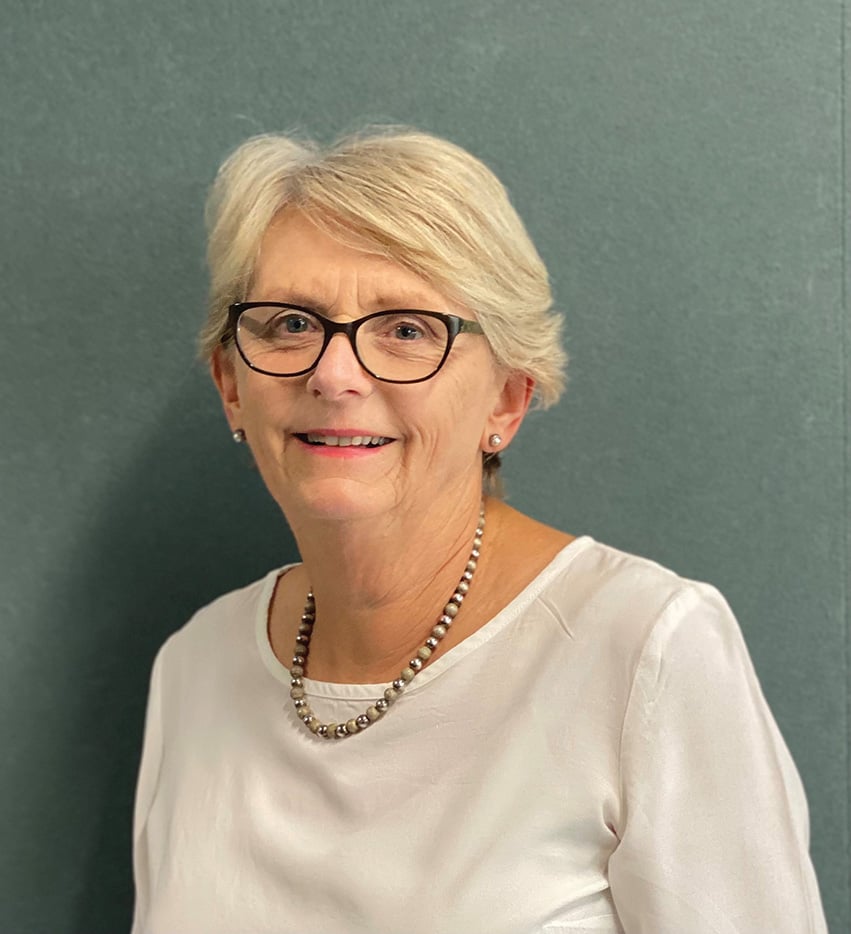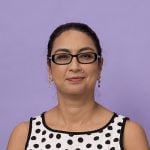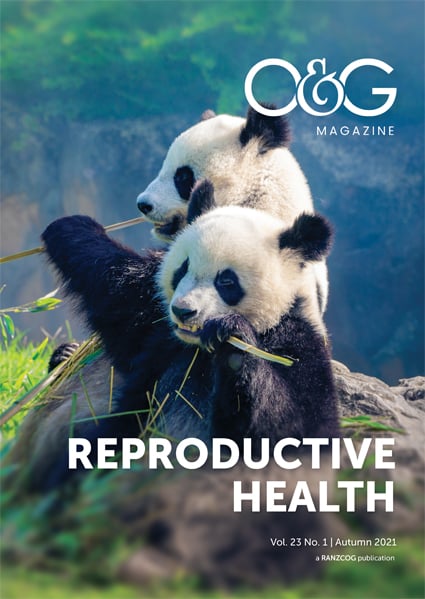This O&G Magazine feature sees Dr Nisha Khot in conversation with RANZCOG members in a broad range of leadership positions. We hope you find this an interesting and inspiring read. Join the conversation on Twitter #CelebratingLeadership @RANZCOG @Nishaobgyn
Prof Cindy Margaret Farquhar
FRANZCOG
Welcome to 2021! A very happy new year to all our readers. As we approach the end of summer, we are all hoping for a more ‘normal’ 2021. In keeping with the theme of this issue, Leaders in Focus features Prof Cindy Margaret Farquhar. Prof Farquhar trained in medicine at the University of Auckland and went on to complete her speciality training in obstetrics and gynaecology in the UK. She has over 300 peer-reviewed publications and has led a number of clinical trials in subfertility and gynaecology. She has led the Cochrane Gynaecology and Fertility Group since its inception in 1996. She is the past Chair of the board of the NZ Guidelines Group and the past Chair of the Perinatal and Maternal Mortality Review Committee. In 2014, Prof Farquhar was awarded Companion of the New Zealand Order of Merit for her contribution to women’s health. In 2019, she was made a Fellow of the Royal Society of New Zealand.

Could you please describe your current leadership roles?
I am the newly appointed Dean of Research and Policy at RANZCOG. I am responsible in part for the development of evidence-based processes and documents within the college. This is a new role established by the College and I am excited by the possibilities for improving outcomes for our patients.
I also lead the Cochrane Gynaecology and Fertility group, a co-director for Cochrane NZ and also a senior editor for Cochrane. I am the Deputy Chair for the WHO Fertility Guidelines currently under development. In my academic role, I am the Postgraduate Professor of O&G at Auckland University and in my clinical role, the Clinical Director of Gynaecology and Medical Director of Fertility Plus for National Women’s.
Were you always interested in O&G? What made you choose it as your career path?
I only became interested in O&G as a junior doctor while I was doing the diploma, thinking that this would be good training for general practice. It was a refreshing change from the patients with chronic diseases in the medical and surgical wards at the time. In particular, I found I really enjoyed helping people become parents and also found women with menstrual problems was something that we could really help with.
What advice would you give to junior doctors who are unsure if a career in O&G is for them?
The after-hours work in O&G is a significant burden and this cannot be ignored for the majority of O&G specialists. There were many, many days after I had done a night on-call when I thought we made a real difference – whether it was reading an abnormal CTG and delivering a baby before any harm occurred or diagnosing an ectopic before major haemorrhage or correctly managing an ovarian torsion. Although the hours can be long and onerous, our role makes a real difference to women with these problems. Anyone contemplating a career in O&G should weigh up the out-of-hours time commitment with the satisfaction of having a fulfilling career.
What does a typical day look like for you?
I like to get up early and get on with things. During COVID, I started doing some yoga stretches at home. I have tried to continue a 20–30-minute routine (although not always successfully). Often there is an early teleconference to attend. I am generally in the office or clinic by 8am. My day is usually a combination of clinical leadership and research meetings, teaching and clinical patient care. I stepped away from the after-hours on-call roster five years ago and I have stopped doing major procedures. I continue to do some day cover for acute call as well as some minor surgery.
How do you balance your personal and professional life? What are your interests outside of work?
We always have great holidays! We have a beach house and love all the usual beach activities. I enjoy hiking and cycling (thank goodness for e-bikes!), going to plays and concerts. We walked the Inca Trail (the four-day one) in 2017, which was a real highlight. I do some gardening and I love cooking. We have two children and one grandson.
What are the major/significant changes that you have noticed in your time as an O&G specialist?
For a gynaecologist, the reduction in the use of hysterectomy has been phenomenal. When I first started as a consultant, I used to do at least two hysterectomies on each half-day operating list as well as a few minors. The hysterectomies were either vaginal or abdominal. Now they are far less common and mostly laparoscopic. The length of stay has reduced from 3–6 days to 1–2 days, but the surgical time has gone up. On the one hand, it is great that women have many non-surgical options for treatment of heavy periods such as Mirena, but on the other hand, the reduction in the number of major surgical procedures has a detrimental effect on junior doctors looking to hone their surgical skills. I am not sure that I have the solution to the reduction in surgical experience, but I am pleased to see the advances in the management of a range of menstrual disorders.
For people with fertility problems, we have many more options than we used to have. I was working as a SHO at National Women’s when the first IVF baby was born in 1983. We didn’t know who the patient was and the confidentially was maintained. When IVF was first introduced, it was offered only to those with tubal infertility. Gradually, couples with unexplained infertility were included and then, with the advent of ICSI, we could treat male factor infertility. With egg donation, this expanded further to include women who did not have many options prior to this. The world of fertility treatment is very diverse these days and patients have many more choices. At the same time, we have more responsibility to provide patients with evidence for (and against) all the different options. Mostly it is expensive and much of my research activity has focused on looking for cost effective and safe options for infertility. And for the past few years our group has focused on the role of add-ons and their effectiveness. It may surprise some of you that most add-ons have not been proven to be effective and are probably overused. This will continue to be a major area of research as fertility services seek to find ways of improving the success rates of IVF.
How did you come to be an academic?
I was fortunate enough to be appointed as a lecturer in London in 1986, where I was able to lead a randomised controlled trial (RCT) that was eventually published in BJOG in 1989. That started my interest in teaching and research. I returned to NZ and was appointed as a job share with a colleague to National Women’s Hospital.
In 1993, I attended the RCOG’s Annual Scientific Meeting in Hong Kong where I listened to a presentation by Dr Richard Johansen about an RCT of vacuum extraction followed by a systematic review of trials of forceps and vacuum extraction. After his presentation, he explained that Dr Iain Chalmers of the UK National Perinatal Epidemiological Unit was starting an interesting project and planned to publish systematic reviews of all healthcare. I was intrigued and wrote to Iain (with an old-fashioned airmail letter in a stamped envelope!) asking if anyone was interested in systematic reviews on treatments of endometriosis. Dr Chalmers replied promptly to say that no one had shown any interest in any of the gynaecology topics. We met in 1994 and, somewhat surprisingly, he asked if I would like to lead the gynaecology topics for this new venture, which was to be known as the Cochrane Collaboration. In order to prepare, I arranged to do a sabbatical in Oxford in 1995. I prepared an application to register the Cochrane Menstrual Disorders Group. This was officially opened in 1996 and in 1998 we added subfertility topics to our remit. In 2016, we celebrated 20 years of what is now the Cochrane Gynaecology and Fertility Group. However, it all started at a conference…and a cheeky letter…
Do you have some ‘secrets of adulthood’ to share with our readers?
To quote Steve Jobs, ‘The only way to do great work is to love what you do.’ My secret, if it can be called that, is that I have loved every aspect and every bit of work that I have done, both clinical and non-clinical (well almost every bit of it….).
What have been the greatest challenges and vulnerabilities during your career and how did you manage to conquer them?
When I first started my research career, I struggled to get funding. This went on for years, but I kept making applications. I think changing tack to focusing on prioritised research topics and undertaking studies with a high-quality study design and working as part of larger network was the key to being successful. Last year our group was successful with a large Health Research Council grant that will fund a clinical trial of IUI and IVF for three years. It was the largest grant I have ever received but it comes after three decades of being a researcher.
What does the future look like? What plans do you have for the next stage of your career?
At this point in time, the future looks a bit busy. I am excited about my new role at RANZCOG. The College membership is justified in expecting the College to take the lead in providing evidence-based advice to guide clinical practice in O&G. The College is well placed to advocate for women’s healthcare and to combat misinformation. In short, there is much to do in 2021 and beyond.






You continue to be such an inspiration to women following in your footsteps Cindy. I have loved reading this interview, and understanding the path that lead you to where you are now. It’s particularly heartening to read how you have enjoyed so much of your career at every stage, which has kept you energised and enthused. You have had a hugely positive influence in my career so far and I hope to channel some of your passion and energy to encourage those coming after me.